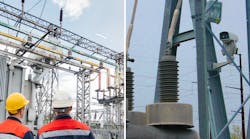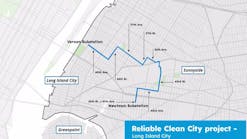Comparing Approaches to Remote Substation Monitoring – Why a Touchless Approach Is Better
In the US alone, more than 55,000 substations and 7 million miles of high voltage transmission and distribution lines transmit more than $400 billion of electricity each year.
Many of the substations are in remote locations that are difficult to access. Outages at these facilities can have significant consequences for businesses and consumers who depend on reliable access to electricity. The US Department of Energy estimates that outages cost US businesses as much as $150 billion per year. Aging infrastructure has meant that the frequency of these outages has increased six-fold between 2000 and 2014.
The cost of outages to utilities is also significant. Transformers can cost millions of dollars to replace, and regulatory bodies can impose fines on utilities that fail to meet reliability standards or restore power within a required timeframe. These fines can range from hundreds of thousands of dollars, such as the recent case of Nova Scotia Power, to hundreds of millions, like in the case of PG&E following violations related to planned power outages in response to wildfires.
Under increasing pressure to avoid outages, reduce maintenance and repair costs, and gain a more complete view of their substations, utilities need a new approach to remote substation monitoring that ensures potential issues are rapidly detected, identified, and resolved before a significant failure.
The Need for Remote Substation Monitoring
There are many opportunities for failure within a remote substation. Transformer leaks, insulation breakdown, corrosion, wear and tear on moving parts, and animal intrusions are just some of the issues that can result in an outage.
Substation monitoring ensures utilities can repair equipment before small issues grow into more serious problems. However, conducting substation monitoring at these facilities can be difficult, time-consuming, and expensive, especially when substations are located far away from major cities or other infrastructure.
The Limitations of Traditional Approaches to Substation Monitoring
Traditionally, substation monitoring has been conducted in two ways. In the first, utilities dispatch a crew to conduct a physical inspection of the site. Truck rolls are conducted on a scheduled basis, or in response to a known incident. Technicians then use handheld thermal sensors and other measurement tools to assess the facility and record the data manually for future analysis.
The limitations to this approach are obvious. Not only is it time-consuming and expensive to send a team to each site, but manual data entry also increases the likelihood of errors, omissions, or incomplete and inaccurate data. Moreover, the data is dependent on the time and location the measurement was taken, leaving little opportunity to conduct deeper analysis, spot trends, or identify issues that only occur under certain load or environmental conditions.
In response to these limitations, many utilities have implemented specialized wired sensors that are installed to monitor each piece of equipment. These sensors collect data and report it to a centralized location for analysis.
Wired sensors have significant advantages over periodic physical inspections, but there are still some important limitations. Because the sensors are often installed on the equipment, utilities must schedule outages during deployment. Wiring the power and communications to each sensor is also a consideration that can add significant expense. Additionally, hundreds or thousands of sensors in a single substation adds complexity and makes the facility more difficult to manage. And while steps have been taken to move toward more open standards and protocols, integration issues can still occur between sensors from different vendors.
A Better Approach – Touchless Remote Substation Monitoring With Thermal Sensors
Rather than install hundreds of dedicated and specialized sensors, utilities can leverage a small number of thermal and visual sensors. Because each touchless sensor can continuously monitor multiple high-value assets and don’t require physical contact to the equipment, utilities can save on installation costs and monitor the performance and health of the substation more effectively.
Because many components of a substation will generate heat if there is a problem, sudden or prolonged temperature changes are often a good indicator that something is wrong. Essentially, a touchless approach automates the manual, handheld thermal scanning process already in use by utilities while dramatically reducing the cost and time required to take the measurements.
Utilities can set temperature ranges and receive automatic alerts if sensors detect a temperature outside these defined limits. These readings are then interpreted by an Asset Management Application which applies advanced analytics to detect trends, identify the issue, prioritize the response, and ensure the most effective allocation of resources and staff.
With touchless remote substation monitoring, utilities can move away from scheduled maintenance and toward Condition Based Maintenance, where crews are dispatched proactively to repair an issue before it results in catastrophic failure.
Improved Remote Substation Monitoring for Lower Cost and Increased Reliability
Reliability and outage avoidance are key responsibilities for utility companies. Meeting these conditions requires substation monitoring to ensure equipment is properly maintained. With a touchless approach using thermal and visual sensors, small temperature changes can be detected in real-time. Compared to alternative approaches, utilities can continuously monitor the condition of their facilities, allocate resources, and manage their assets more effectively, all before arriving at the site.
Richard Harada is Vice President Product Management & Marketing at Systems With Intelligence.
For more information contact us at [email protected], or visit our website at www.systemswithintelligence.com.
Follow us on LinkedIn.
Sponsored By:



